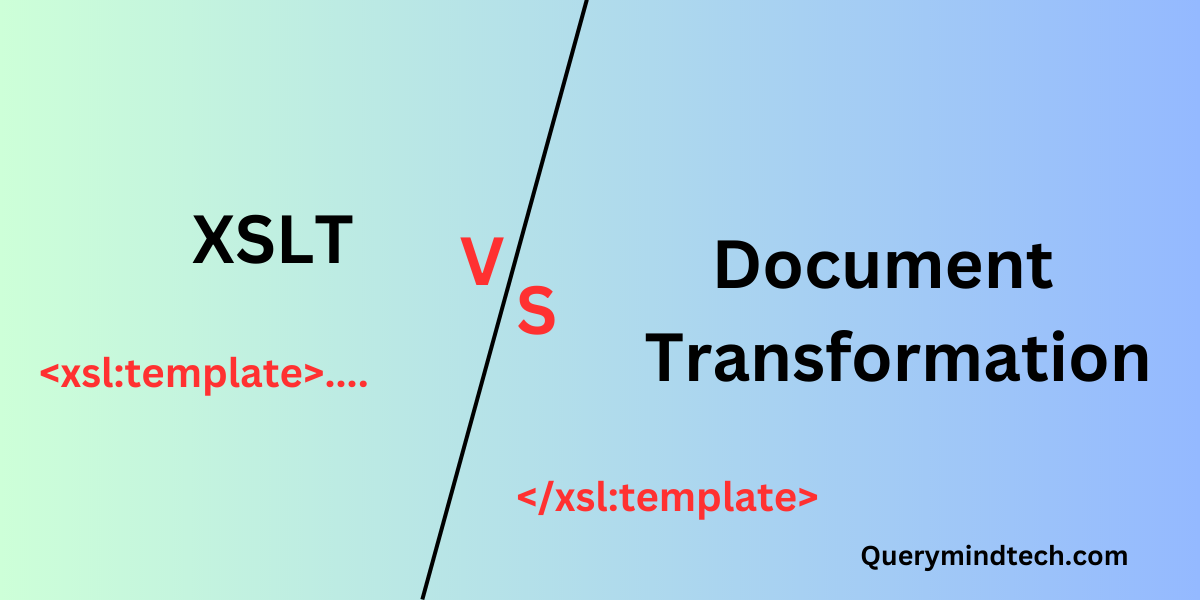In the world of web development and data manipulation, transforming data from one format to another is a common requirement. Two popular methods for achieving this are XSLT (Extensible Stylesheet Language Transformations) and document transformation. While both serve similar purposes, they have distinct characteristics and use cases. In this article, we’ll dive into the details of the Difference Between XSLT and Document Transformation, its strengths, and when to use each one.
Understanding XSLT
What is XSLT
XSLT, an acronym for Extensible Stylesheet Language Transformations, is a powerful and widely-used language for transforming XML documents into different formats. It is a language that defines the rules for transforming the structure of XML data. With XSLT, you can convert XML data into various output formats, such as HTML, plain text, or even other XML structures. XSLT uses the XPath Langauge for node traversing.
How XSLT Works?
At its core, XSLT operates on the principle of matching patterns in XML documents and applying templates to those patterns. It uses XPath expressions to navigate through the XML structure and select specific nodes for transformation. XSLT stylesheets contain a set of rules that define how the XML elements should be transformed into the desired output format.
The Concept of Document Transformation
Defining Document Transformation
Document transformation, on the other hand, refers to the process of converting documents from one format to another without relying on XML or XSLT. It encompasses a broader scope, including transforming formats like JSON, CSV, or proprietary document formats.
Use Cases of Document Transformation
Document transformation is commonly used in scenarios where XML is not the primary data format, and developers need to manipulate data without converting it into XML first. It’s often employed in data integration, ETL (Extract, Transform, Load) processes, and API interactions.
Key Differences Between XSLT and Document Transformation
Approach to Data Transformation
XSLT focuses specifically on XML data transformation, employing a rule-based approach using templates and patterns. Document transformation, on the other hand, deals with various data formats, making it more versatile in handling different types of data.
Target Data Formats
XSLT primarily targets XML-to-XML transformations, but it can also convert XML to other formats like HTML and text. Document transformation supports a wide range of formats, including XML, JSON, CSV, Excel, and more.
Complexity and Flexibility
XSLT’s rule-based nature can make complex transformations challenging to achieve. Document transformation offers more flexibility, especially when dealing with non-XML data.
Browser Compatibility
XSLT is well-supported by modern browsers, making it suitable for client-side transformations. Document transformation is often preferred for server-side processing, as it eliminates browser compatibility concerns.
Performance Considerations
XSLT transformations can be resource-intensive for large datasets, potentially impacting performance. Document transformation’s performance is influenced by the tools and libraries used.
Learning Curve and Implementation
XSLT has a steeper learning curve due to its specific syntax and concepts. Document transformation, especially with libraries like Pandas or JavaScript, can be more accessible to developers.
When to Use XSLT?
Use Cases for XSLT
- Converting complex XML structures into HTML for web display.
- Applying consistent styling to XML data for presentation purposes.
When to Use Document Transformation?
- Processing and transforming non-XML data formats like JSON or CSV.
- Integrating data from multiple sources into a unified format.
Advantages of XSLT
- Precise control over XML data transformations.
- Ideal for XML-centric projects.
- Well-established and widely supported.
Advantages of Document Transformation
- Versatility in handling multiple data formats.
- Easier integration with non-XML-based systems.
- Performance advantages for server-side processing.
Limitations of XSLT
- Complexity in handling non-XML data.
- Resource-intensive for large-scale transformations.
Limitations of Document Transformation
- May require third-party libraries for specific formats.
- Less control over XML-specific features.
In conclusion, both XSLT and document transformation play crucial roles in data manipulation and transformation. XSLT is best suited for XML-centric projects, providing precise control over XML data transformations. On the other hand, document transformation offers greater versatility, handling various data formats beyond XML. The choice between the two depends on the project’s requirements and the data formats involved.
Can XSLT handle non-XML data formats?
Answer: XSLT is primarily designed for XML-to-XML transformations, but with some extensions, it can handle non-XML formats as well. However, for better versatility, document transformation might be a more suitable choice.
Is document transformation faster than XSLT for large datasets?
Answer: The performance of both approaches depends on various factors, including the size of the dataset, the complexity of transformations, and the tools used. In some cases, document transformation may offer better performance, especially for non-XML data.
Can I use XSLT on the client side?
Answer: Yes, modern browsers support XSLT transformations on the Client side.

